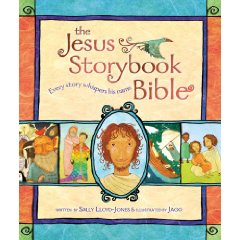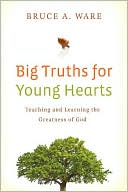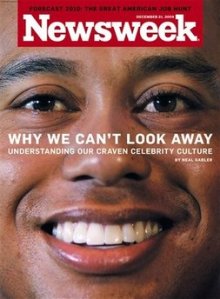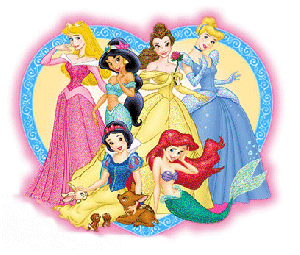Today, three books you might want to check out.

There are children’s Bible storybooks out there that present a bunch of pretty fun, dramatic stories . . . but don’t explain the gospel. So kids read about, say, a super-strong guy named Samson and a big boat full of animals, but that guy and that boat have no relation to Jesus, and they don’t really tell the kids anything about how those stories can relate to them. And there are children’s Bible storybooks out there with pictures, but the pictures just aren’t that great. The Jesus Storybook Bible, written by Sally Lloyd-Jones and illustrated by Jago (Zondervan, 2007), avoids both problems. It’s smart, fresh, and Jesus-focused. And Jago’s illustrations preserve that legacy of talented guys with one name (Bono, Pele, Fabio et al).
One good thing she does, right off the bat, is not to start with Genesis 1 but with Psalm 19 (“the word of God is sweeter than honey . . .”) and Hebrews 1 (“God has now spoken to us through his Son”), so she can explain what the whole Bible is about. It reflects the idea that you don’t know what chapters are really about if you don’t understand the whole book/movie/play. She writes, “No, the Bible isn’t a book about rules, or a book of heroes. The Bible is most of all a Story. It’s an adventure story about a young Hero who comes from a far country to win back his lost treasure. . . . There are lots of stories in the Bible, but all the stories are telling one Big Story. The Story of how God loves his children and comes to rescue them.” Nice!
I’ll give you an example of how this works in her book. It comes from the Adam sin story of Genesis 3. (By the way, not a bad chapter to look at in any Bible book you’re thinking of getting, as my friend Laura pointed out to me.) “You see, sin had come into God’s perfect world,” she explains. “And it would never leave.” After God sends Adam and Eve out of Eden, she says, “Well, in another story, it would be all over and that would have been . . . The End. But not in this Story. God loved his children too much to let the story end there. Even though he knew he would suffer, God had a plan–a magnificent dream. One day, he would get his children back. One day, he would make the world their perfect home again.”
When I showed the book to my three-year old girl, she was excited to leaf through it. We read one story together, the story of Namaan the leper. (She saw the picture of his face looking sad and she wanted to read about why it was like that–she’s into princesses and sad people. And, yes, sad princesses take the cake.) And it was a nice chance to talk about forgiveness and being nice to people who aren’t nice to us–just like Jesus is.
It should be noted that this is not an actual Bible but a collection of stories from the Bible, stories told very well. I highly recommend this book. (And, I should say, so does Pastor Brian, who’s been reading this for a little while with his kindergardener.)

So, one day last summer, I was talking with Pastors Mark and Brian about how to explain the Holy Spirit to kids. And we ended up saying, “Someone should write a systematic theology book for kids!” Well, look what came to Amazon. OK, it’s not quite what we were picturing, but Big Truths for Young Hearts (Crossway, 2009), by Bruce Ware, a theology professor at Southern Baptist Theological Seminary, comes close. It’s not readable for young kids, for sure, though teens could read it. Parents might really like this though, as it walks us through major topics of our faith in a way that makes sense to our kids.
If you just happen to pull out one of the, I’m sure, many systematic theology textbooks on your shelf, you’ll see that the table of contents probably goes something like: The Word of God, God, Man, Jesus, the Holy Spirit, salvation, the church, and the future. Ware follows the same outline in this book for kids. It starts out with the way God makes himself known (“Has anyone ever kept a secret from you? . . . No matter how much you might want to know the secret, until someone tells you, you just cannot know what it is. It is this way with knowing who God is. . . . God has shared with us the secret of who he is”) and ends with the end of history as we know it (“When the knowledge of the Lord covers the earth as the waters cover the sea . . . this will be the greatest thing that will happen when all things are made new”).
This book came out of conversations Dr. Ware had with his two daughters, now adults, as they grew up. It started, he says, when they were six and two. The girls were always wired right before they went to sleep, so Dr. Ware decided, in order to keep his “sanity” (his word), to use that time to teach them about Christian doctrine. And he started going through the same lessons he was teaching during the day at the seminary! I’d wonder how much of it was him wanting to capitalize on their energy or him wanting to put them to sleep, but it seems like the former was pretty genuinely in view. 🙂
Again, I’d give a strong recommendation of this book to parents–and really, to anybody–to get deep and important Christian doctrines presented simply and well.

The third and last book I’ll talk about was also published in 2009; it’s called Gospel-Powered Parenting, by William P. Farley (P&R Publishing), a pastor in Washington state. The title excited me, just like the introduction to Sally Lloyd-Jones’ Storybook Bible did; it’s unfortunately too rare that you see (Christian!) parenting books that talk a lot about the gospel. And Farley’s book does come through that way, overall.
His basic point, presented in the first few chapters, is that parents need to focus on their kids’ hearts, not externals like environment, as we raise them. We do that by teaching and modeling the gospel. It’s a really good point that seems like a given, but as he continues to write, it gets apparent how radical and rare gospel-driven parenting it.
Particularly cutting is his contrast between the goals of secular parenting and Christian parenting. Secular parenting tries to transfer morality, so that kids “conform to society’s expectations, such as admittance to Ivy League schools, success in business, or marriage to the ‘right’ people.” Christian parenting has “one goal during this short window of opportunity. It is to transfer the baton of faith in Christ to the next generation.”

Maybe a 70s-era Christian introduced Keith Green to you. If no one did, he's really worth checking out.
It’s like Keith Green became a parenting author. I know we wrestle with issues like this as Christians in suburbia–we did, after all, choose our neighborhoods for a reason–and I know many of our Christian parents wrestled too, as they tried to define what was best for us. (And, for some of us, for better or worse, they’re still doing it.)
Chapters 4 and 5 are basically presentations of the gospel, which are helpful and a welcome sight.
The latter part of the book is much less helpful. Farley seems to bite off more than he can really chew as he gets into areas where he doesn’t have expertise: homosexuality, gender, and cultural opinions concerning authority.
One more thing to mention about the book, he makes a strong exhortation to fathers to lead the spiritual upbringing of children. He quotes Nancy Gibbs, a religion writer for Time, who made the interesting observation in a 1993 article that most parenting books were written for fathers, not mothers, until the 1830s. Now it seems to be the reverse. Without going into which is better, at the very least we can say that we want both involved. Fathers, I think this is something to think about. Just one question to put out there (and I don’t have an answer for it): why do you think men buy and probably read less parenting books than women?










